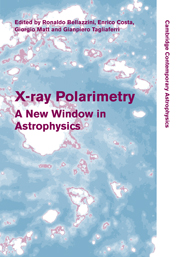1 - X-ray polarimetry: historical remarks and other considerations
Published online by Cambridge University Press: 06 July 2010
Summary
We briefly discuss the history of X-ray polarimetry for astronomical applications including a guide to the appropriate statistics. We also provide an introduction to some of the new techniques discussed in more detail elsewhere in these proceedings. We conclude our discussion with our concerns over adequate ground calibration, especially with respect to unpolarized beams, and at the system level.
Introduction
Sensitive X-ray polarimetry promises to reveal unique and crucial information about physical processes in and structures of neutron stars, black holes, and ultimately all classes of X-ray sources. We do not review the astrophysical problems for which X-ray polarization measurements will provide new insights, as these will be discussed in some detail in many of the presentations at this conference.
Despite major progress in X-ray imaging, spectroscopy, and timing, there have been only modest attempts at X-ray polarimetry. The last such dedicated experiment, conducted by Bob Novick (Columbia University) over three decades ago, had such limited observing time (and sensitivity) that even ∼10% degree of polarization would not have been detected from some of the brightest X-ray sources in the sky. Statistically significant X-ray polarization was detected in only one X-ray source, the Crab Nebula.
History
The first positive detection of X-ray polarization was performed in a sounding-rocket experiment that viewed the Crab Nebula in 1971. Using the X-ray polarimeter on the Orbiting Solar Observatory (OSO)-8, this result was confirmed with a 19-σ detection (P = 19.2%±1.0%), conclusively proving the synchrotron origin of the X-ray emission.
- Type
- Chapter
- Information
- X-ray PolarimetryA New Window in Astrophysics, pp. 1 - 8Publisher: Cambridge University PressPrint publication year: 2010
- 1
- Cited by



